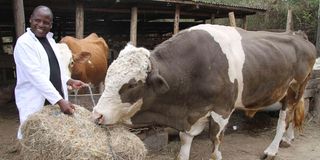Getting breeding stock requires good and careful planning

A Fleckvieh cow at a farm in Karen, Nairobi, on July 9, 2014. The breed, valued for its large size and production of milk and meat, is popular in Germany.
There is a general assumption locally and in the region that Kenya has an abundance of livestock breeding stock that can be obtained easily on order.
However, the assumption is far from the truth though Kenya is a good supplier of breeding animals locally and eastern Africa.
In the course of my practice, I have had inquiries from people in Kenya and neighbouring countries looking for breeding animals.
The most sought after are dairy cattle of the Jersey, Friesian and Ayrshire breeds. People asking for beef breeds mainly look for Boran, Sahiwal and the Aberdeen Angus.
The other breeds of livestock sought after are Dorper sheep, Galla, Boer and Kalahari Red goats for meat. Non-livestock animals like dogs re also in demand.
Two weeks, ago I got an urgent enquiry that would prove difficult to fulfil.
Juma from a neighbouring country had jetted into Kenya, hoping to leave with 10 pedigree Jersey heifers and an equal number of Fleckvieh.
I knew from the outset that it was a tall order, particularly for the Fleckvieh. This breed is relatively new in Kenya, having been introduced sparingly by private farmers.
The uptake of the breed did not go well because there was no wide-scale popularisation and provision of the breeding material.
The Fleckvieh is a cattle breed popular in Germany. It is valued for its large size and production of meat and milk. Very few pure Fleckvieh were brought in Kenya.
Most of the breed genetics are crosses with Friesians because the promoters of Fleckvieh supplied semen rather than the pedigree stock.
As a result of the private sector breed introduction strategy, the hype for the Fleckvieh died a natural death, leaving only many white-headed crosses with Friesians.
I must say the Fleckvieh, as a breed, is a beautiful, imposing and heavily muscled animal that leaves the impression of something one would wish to have.
The big question though is why spend on muscle that one would not realise as profit until the animal has stopped producing milk to become meat?
This is another reason that made the breed unattractive to local farmers.
When Juma called, he said he had visited some farms but had been referred to me for assistance in finding the animals he desired.
Juma said he needed the animals to be pedigree and seven to eight months pregnant.
Pedigree are those animals with verifiable continuous breeding records.
According to him, the animals he would get needed to be able to withstand one week of road travel.
That last condition made me advise Juma to revise the stage of pregnancy.
Cows in their seventh and eighth months of gestation should not be subjected to a lot of stress like one week of overland transport as they are likely to abort.
Extreme stress causes the release of cortisol; a hormone that induces calving.
Juma would need to transport animals that were six months or less pregnant or opt for the expensive air freight.
We settled on animals between four and six months pregnant.
I further advised Juma that we would look for the Fleckvieh but it was unlikely for him to get pure pedigree animals of the breed in Kenya and at the stage of pregnancy he wanted.
On further discussions, he agreed we could substitute the Fleckvieh with Ayrshire if they were not available.
For the Jerseys, there was some likelihood of getting suitable animals.
Unfortunately, the current prolonged drought that has hit most of the country worked against Juma’s wishes.
Having clarified the factors against his wishes, I set out to look for Juma’s preferred animals and possible alternatives. My search for Fleckvieh turned blank.
First, there was no one with pedigree heifers of the breed. What was available was scanty and mixes with Friesian. But I did get pedigree Ayrshires from one farmer.
The most prospective Jersey breeder had sold all his commercial pregnant heifer stock of 30 to a neighbouring country about a month earlier.
He had heavily scaled down breeding due to a shortage of feed.
The breeder could only promise a possible supply much later in the year if the weather became favourable.
Another key Jersey breeder in Nakuru also cited heavy reduction in breeding and slowed growth rate of young animals due to the drought.
Other Jersey breeders I contacted turned blank, citing the impact of the adverse weather.
In fact, two of them said they had already closed their breeding operation and sold their animals due to shortages of feeds and water.
The lesson for Juma and all farmers looking to acquire specified breeding stock was very clear.
It is very important to plan well before setting out for the search. We call live animals biological assets.
They are very different from inanimate items and are always changing by the day because they grow, deteriorate or surpass certain favourable stages with time.
Farmers wishing to acquire biological assets should gather good information on availability of the animals of their specifications.
They should set specifications that are based on scientific standards and have a well-grounded expert in the market they wish to acquire the animals from.
The recommended practice is to identify verified breeders of the animals required and enter into a supply contract.
That way, the animals are prepared up to the stage needed and delivered when ready.
I agreed with Juma that he would shift his cattle search to contracts with the Ayrshire and Jersey breeders to ensure he got the animals of his choice and in the state and numbers he wanted.





